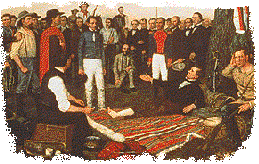
![]()
 The Battle of San Jacinto - The last important battle of the war
for Texas independence, won by General Sam Houston and his 800
men, fighting Santa Anna's 1400 troops, a small part of the Mexican army. On a peninsula of land at San Jacinto, in a battle which lasted 18 minutes, the Texans surprised the Mexican army and ended the war. Houston dictated armistice terms that established de facto independence. Nine (or fewer) Texans and about 630 Mexican soldiers were killed. Houston was one of the several Americans wounded -- his ankle was shattered.
The Battle of San Jacinto - The last important battle of the war
for Texas independence, won by General Sam Houston and his 800
men, fighting Santa Anna's 1400 troops, a small part of the Mexican army. On a peninsula of land at San Jacinto, in a battle which lasted 18 minutes, the Texans surprised the Mexican army and ended the war. Houston dictated armistice terms that established de facto independence. Nine (or fewer) Texans and about 630 Mexican soldiers were killed. Houston was one of the several Americans wounded -- his ankle was shattered.
Sand-hogs - Workers in tunnels who breathe compressed air.
Anthony Frederick Augustus Sandys(1829-1904) - Pre-Raphaelite painter, portraitist, and illustrator. His first painting to attract notice, "The Nightmare," satirized Millais's "Sir Isumbras at the Ford." His woodcuts and illustrations, a unique blend of Pre-Raphaelite subject matter and Durer-like precision, were his most important contribution.
![]()
![]() About Sandys
About Sandys
Sappers - Military engineers who do field fortification work. Slang for The Royal Engineers, from the late 19th century, because they amalgamated with the Royal Sappers and Miners in 1855.
Sapping - The laying of a trench from within the trench itself to a point beneath enemy fortifications.
Satsuma - A large domain on the southern Japanese island of Kyushu, dominated in the Edo period by the great samurai clan of Shimazu. At the end of the Tokugawa period, the southern provinces of Satsuma and Choshu were home to a number of young samurai of relatively humble origins who sought the overthrow of the Tokugawa shogunate. These two domains, on the periphery of Japan geographically, historically cherished strong anti-Tokugawa sentiments. In addition, they were more solvent financially than other domains, and could afford to purchase superior Western arms.
![]()
![]() A guided tour of historic Satsuma
A guided tour of historic Satsuma
The Satsuma preference - A Northern-Japanese reference to homosexuality.
Seiyoken - A huge, famous, and rather ugly restaurant in the Ueno district of Tokyo. A hotel of the same name operated in the Tsujiki foreign quarter in the 1870s. Food suitable for foreigners was brought from the Yokohama foreign settlement by runner.
Shimonoseki bombardment - When Bakufu reneged on its agreement to expel foreigners by June of 1863, the Choshu domain, in response to a general order to repulse foreigners that was forced upon the Edo government by the conservative court in Kyoto, attacked Western ships. In 1864, Western ships, in retaliation, bombarded Shimonoseki and landed troops. A peace agreement was signed, and Choshu moved from anti-foreign policies to opposing Bakufu. Satsuma allied with Choshu to this end in 1866.
Statistical societies - These were established in London and other cities in the 19th century with the interest of creating a science of society by collecting information from which general laws could be established, as in the physical world.
Statistical Society of London - Now the Royal Statistical Society,
it was founded in 1834 with the object of procuring, arranging and publishing "Facts calculated to illustrate the Condition
and Prospects of Society," limited as far as possible to "facts which can be stated numerically and arranged in a
table." Charles Babbage was one of the founders.
![]()
![]() Apply for membership in the Royal Statistical Society
Apply for membership in the Royal Statistical Society
Steam car - Although steam cars were built, they never attained much commercial success as highway vehicles because it was difficult to maintain an adequate water supply.
![]()
![]() The Curtis steam car
The Curtis steam car
Suez Canal - The history of the construction of the Suez canal is one of French engineering expertise and British machinations, overt and covert, to prevent its being built. France entertained the idea of a canal between the Mediterranean and the Red Sea during the 17th and 18th centuries, and Napoleon sent engineer Charles Lépère in 1798, but they were dissuaded from building it because, until 1853, it was thought that the Red Sea was thirty feet above the level of the Mediterranean. The British government used all its considerable influence to obstruct construction of the canal for more than a decade after that. When offered the opportunity to buy a share in the canal, they declined, and they continued to create difficulties even after the beginning of construction. The canal was formally opened in 1869, with the French to have a 99-year lease. Within a month of his finishing the canal in 1869, Ferdinand De Lesseps was received by Queen Victoria, honored at a fete held at the Crystal Palace, and showered with British honors. After the opening of the canal, its history is one of increasing British control, starting with the acquisition, under Disraeli, of a large block of shares in the canal company. Disraeli's actions in this regard have been termed the greatest service to England of his long career, consolidating British power in the Mid-east.
Captain Swing - In the uprising of 1830, there were a number of outrages -- broken threshing machines, burning of ricks and barns against farmers who had adopted the use of agricultural machinery. "Captain Swing" was the signature most often attached to threatening letters sent to landowners and wealthy farmers in England in these times, 1830-1833.
Sybil, or The Two Nations - A novel by Benjamin Disraeli, published 1845. The two nations are the rich and the poor. The novel describes the conditions of the working class with sympathy and deals with the conditons that lead to the Chartist revolt in 1838. It tells the story of Charles Egremont, younger brother of the evil Lord Marney, who falls in love with a beautiful young religious novice, Sybil, daughter of the Chartist Walter Gerard. Egremont learns about the lives of the rural poor and begins to understand the complaints of the Chartists and rick burners. Disraeli's skill at limning character in a few words of dialogue is most evident in his portrayal of Dandy Mick, a 16-year-old factory worker of acid attitude, given to long, loose white trousers, pink silk neckerchiefs, and gorgeous pins of questionable material. In the course of the novel, however, the reader comes in for a number of lectures on English history and politically correct thought. At the end, of course, after scenes of suitably violent rioting and the death of Walter Gerard, Sybil and Egremont are reunited with one another and with their rightful property.
![]()
The Difference Dictionary was first published
in slightly different form in Science Fiction Eye, Issue #8.
Text copyright 1990, 1996, 2000, 2003,
by Eileen K. Gunn.


